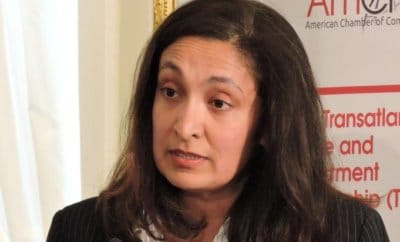Education
Indian American Teens Win National Geographic Bee, Spelling Bee Contests

Venkat Ranjan is announced as the winner of the National Geographic Bee. Journalist Mo Rocca hosted the annual geography competition.
Photo: Mark Thiessen, National Geographic
The 13-year-old California student correctly answered the question, “Which South American country has a population size most similar to Lebanon?”
The three top spots at the recent National Geographic Bee contest were all taken by Indian American whiz kids. Venkat Ranjan, 13, beat 10 other finalists to win the top prize, after answering “Paraguay” to the question: “Which South American country has a population size most similar to Lebanon?”
The 30th annual National Geographic Bee was held at the organization’s headquarters in Washington D.C on May 23.
California resident Ranjan, an eighth grader at Windemere Ranch Middle school, has been entering the competition since 2015. In all, he has topped about 2.6 million kids from fourth to eighth grade from more than 10,000 schools who participated in the competition based on geography and world affairs. With his win, Ranjan got a $50,000 college scholarship, a lifetime membership to the National Geographic Society, a subscription to National Geographic magazine, and an all expenses-paid Lindblad expedition to the Galápagos Islands on board the National Geographic Endeavour ll.
Anoushka Buddhikot, another 13-year-old student from Bridgewater-Raritan Middle School in New Jersey, answered “Guyana” to the final question, and earned the second spot, while 14-year-old Vishal Sareddy from Riverwatch Middle School in Georgia finished third in the competition. Buddhikot and Sareddy got college scholarships worth $25,000 and $10,000, respectively.
“All of you have demonstrated an impressive commitment to geography and maps, and today we’re rewarding that commitment,” National Geographic Society chair Jean Case said at the event.
Case also observed that while they consider themselves map geeks at National Geographic, “geography is about so much more than just memorizing places on map.”
The goal of the Bee is, he added, to “educate, inspire, and celebrate you, our young people because you are our future leaders.”
The national finals started with a group of 54 state and overseas territory competition winners in Washington, D.C., and came down to the final 10. The competition was hosted by journalist and humorist Mo Rocca for a third consecutive year.
Students had to answer various questions, ranging from whether a map of the United States shows homelessness or the literacy rate, the range of the black bear or a ponderosa pine, name of the U.S. state capital on the Pearl River, Sweden’s largest island, and the currency of Denmark. As a test of their analytical skills, contestants were also asked to pick one of three rivers as the best choice to focus on a plastic cleanup effort, to reduce the amount of waste going into the ocean.
The top three finalists chose China’s Yangtze River, saying that the area’s high population and plastic consumption, and limited collection and recycling infrastructure, made it the prime target.
About 120 million students have participated with more than 90 scholarships given out, coming up to a total of $1.5 million since the competition started.
Meanwhile, another Indian American student won the prestigious Scripps National Spelling Bee on June 1. Karthik Nemmani, 14, from Texas won the contest by spelling “koinonia” correctly. With cash and prizes worth more than $42,000, he become the 14th Indian American Spelling Bee champion in 11 consecutive years, since a few contests resulted in joint winners.




You must be logged in to post a comment Login